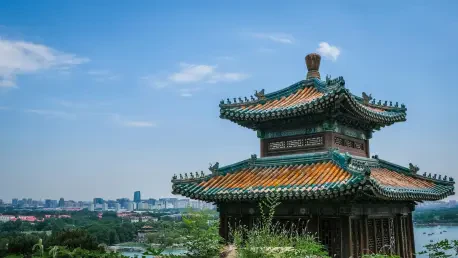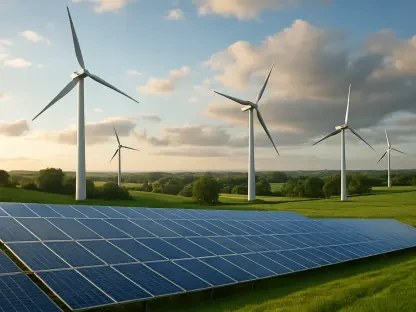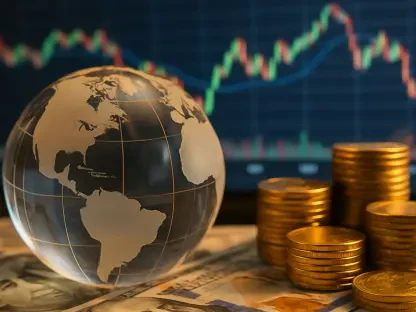In a transformative wave sweeping across China’s economic landscape, investments from Gulf Cooperation Council (GCC) countries are sparking an unprecedented boom in the finance and energy sectors this year, marking a pivotal shift in global capital dynamics. Sovereign wealth funds (SWFs) and corporate powerhouses from the Middle East, wielding trillions in assets, are injecting vital capital into strategic industries at a time when Western foreign direct investment (FDI) is on a noticeable decline. This influx isn’t merely a financial transaction; it represents a profound alignment of interests between China and Gulf nations, driven by mutual economic goals and geopolitical synergy. From bolstering financial markets to securing energy futures, these investments are redefining global capital flows and positioning China as a key partner for the Gulf’s diversification ambitions. As this partnership gains momentum, the implications ripple far beyond national borders, signaling a shift in the balance of economic power. This article delves into the forces propelling this collaboration, examining the scale of capital inflows, the policies enabling them, the sectors benefiting most, and the broader geopolitical context that binds these regions together.
The Rising Tide of Gulf Capital
The magnitude of Gulf investments in China stands as a testament to a shifting global economic order, where Middle Eastern capital is becoming a dominant force. In the previous year, over 60% of sovereign investment inflows into China originated from Gulf SWFs, a trend that continues to accelerate. Entities like Saudi Arabia’s Public Investment Fund (PIF), Abu Dhabi Investment Authority (ADIA), and Qatar Investment Authority (QIA) are at the forefront, managing assets worth trillions and strategically deploying them into China’s growth story. This surge isn’t random; it reflects a calculated move by Gulf nations to diversify their economies beyond oil reliance, tapping into China’s vast market potential as a stable and high-growth destination. The numbers paint a striking picture—Gulf inflows exceeded $10 billion last year, a sharp contrast to the broader FDI downturn, positioning these investors as critical players in sustaining China’s economic momentum.
Beyond the raw figures, the strategic intent behind these investments reveals a deeper narrative of partnership. Gulf countries are not just parking capital; they are aligning with China’s industrial priorities, from infrastructure to technology, to secure long-term returns and economic resilience. For China, this capital serves as a buffer against declining investments from other regions, particularly the West, where geopolitical tensions have dampened enthusiasm. The relationship is symbiotic—while Gulf nations gain exposure to one of the world’s largest economies, China secures a reliable source of funding to fuel its ambitious development plans. This dynamic underscores a pivotal shift, where Gulf capital is not just a stopgap but a cornerstone of China’s economic strategy in the current landscape.
Policies Paving the Way for Investment
China’s proactive policy framework has played a crucial role in attracting Gulf capital, creating an environment where foreign investors feel both welcomed and supported. The 2025 Action Plan, a comprehensive initiative to stabilize FDI, alongside updates to the Qualified Foreign Institutional Investor (QFII) regime, offers tangible benefits such as profit reinvestment incentives and streamlined processes for capital repatriation. These reforms are meticulously designed to reduce bureaucratic hurdles, addressing long-standing concerns of foreign entities about operational friction in the Chinese market. By easing restrictions on domestic loans for overseas firms, Beijing is signaling a clear intent to prioritize partnerships with regions like the Gulf, whose capital is seen as a stabilizing force amid global uncertainties.
The urgency of these policy shifts becomes evident against the backdrop of a challenging FDI landscape, where overall inflows have dropped by double-digit percentages in early reports this year. Facing such headwinds, China’s government has doubled down on fostering ties with Gulf investors, recognizing their potential to offset declines from other sources. These measures are more than cosmetic—they represent a strategic pivot to ensure economic stability by cultivating long-term relationships with reliable partners. The reforms have already borne fruit, as evidenced by the sustained interest from Gulf SWFs, which continue to view China as a priority destination. This policy-driven approach not only facilitates immediate capital inflows but also lays the groundwork for deeper economic integration in the years ahead.
Sectoral Impacts: Finance and Energy in Focus
At the heart of Gulf investments in China lies a robust focus on finance, where strategic stakes are reshaping market connectivity. A standout example is QIA’s significant investment in China Asset Management Co., marking a historic entry into China’s mutual fund sector. This move is more than a financial transaction; it paves the way for enhanced capital market linkages through instruments like exchange-traded funds (ETFs), fostering greater integration between the two regions. Such investments are strategic, aiming to capitalize on China’s growing financial ecosystem while providing Gulf investors with access to a dynamic and expanding market. The ripple effects are profound, as these partnerships strengthen cross-border financial flows and support broader economic objectives.
Energy, a traditional stronghold of Gulf economies, remains a critical pillar of this collaboration, with joint ventures cementing long-term ties. Saudi Aramco’s multi-billion-dollar partnership with Sinopec in Fujian exemplifies this, embedding downstream capacity in China while securing hydrocarbon demand for the Gulf. This alignment serves dual purposes—meeting China’s industrial energy needs and ensuring market stability for Gulf oil producers. Unlike short-term deals, these projects are built on a vision of sustained cooperation, integrating energy security with economic growth. The synergy in this sector highlights how Gulf investments are not merely opportunistic but are deeply intertwined with China’s strategic priorities, creating a robust framework for mutual benefit.
Driving Sustainability and Digital Innovation
Gulf capital is also making significant inroads into China’s renewable energy landscape, reflecting a shared commitment to sustainability. Saudi Arabia’s ACWA Power stands out with its ambitious commitment to over 1 gigawatt of solar and wind projects, leveraging China’s technological prowess in clean energy. This partnership aligns seamlessly with global decarbonization goals and the Gulf’s vision to transition toward a greener economic model. By investing in renewables, Gulf nations are not only diversifying their portfolios but also contributing to China’s push for environmental sustainability, creating a blueprint for collaboration that transcends traditional energy ties. Such initiatives signal a forward-thinking approach, prioritizing long-term ecological and economic gains over immediate returns.
Parallel to green energy, logistics and digital infrastructure are emerging as key areas of focus, with investments poised to bolster China’s export and technology ambitions. ADIA’s substantial stake in GLP, a leading logistics firm, underscores this trend, channeling funds into strengthening export corridors and supporting the digital economy. These investments are strategic, targeting sectors that are vital to China’s role as a global trade hub while offering Gulf investors exposure to high-growth industries. The emphasis on future-proof areas like data infrastructure reflects a nuanced understanding of where global economic trends are heading, ensuring that Gulf capital remains relevant in an increasingly digitized world. This dual focus on sustainability and innovation illustrates the breadth of Gulf investment strategies in China.
Geopolitical Foundations of Economic Ties
Underpinning the surge of Gulf investments in China is a complex web of geopolitical alignments that reinforce economic cooperation. Gulf states are navigating a delicate balance, maintaining historical alliances with Western powers while forging stronger connections with the Global South through platforms like BRICS. China’s Belt and Road Initiative (BRI) further solidifies this bond, weaving a network of infrastructure and trade links that benefit both regions. This strategic positioning allows Gulf nations to hedge against global uncertainties, while China gains reliable partners to counterbalance Western de-risking strategies. The interplay of these geopolitical currents creates a fertile ground for sustained investment, rooted in mutual interests and a shared vision for a multipolar world.
Regional integration efforts add another layer to this partnership, amplifying its significance on the global stage. High-level engagements, such as the ASEAN-GCC-China summit held this year, underscore a collective push toward broader economic collaboration. Ongoing negotiations for a China-GCC Free Trade Agreement (FTA) further signal a commitment to deepening ties, offering a framework for reduced trade barriers and enhanced investment protections. These developments stand in stark contrast to the caution exhibited by Western investors amid geopolitical tensions, highlighting the unique role of Gulf capital as a stabilizing force. The convergence of economic and geopolitical strategies ensures that this relationship is not just transactional but a cornerstone of long-term regional stability.
Charting the Future of Collaboration
Looking toward the horizon, the trajectory of China-Gulf economic ties appears poised for even greater integration, with several catalysts on the near-term agenda. The potential finalization of a China-GCC FTA stands as a game-changer, promising to eliminate tariffs and bolster investment safeguards, thereby unlocking new avenues for capital flows. Financial innovations, such as the expansion of ETFs and Saudi Arabia’s launch of a significant China-focused fund, are set to sustain momentum by simplifying access for Gulf investors. These mechanisms are critical, as they lower entry barriers and ensure that capital continues to flow into China’s priority sectors, reinforcing the partnership’s resilience against external economic pressures.
Beyond policy and financial tools, tangible project milestones are expected to solidify this collaboration into the next year. Developments like new energy complexes and infrastructure initiatives are moving from blueprints to reality, serving as proof points of the partnership’s depth. These operational achievements are vital, as they transform agreements into measurable outcomes, building trust between the two regions. If regulatory consistency and mutual trust remain intact, Gulf investments could evolve from a significant contributor to a permanent fixture in China’s economic framework. The path forward hinges on maintaining clarity in policies and delivering on commitments, ensuring that this alliance continues to thrive as a model of strategic economic cooperation.









